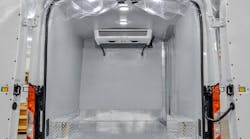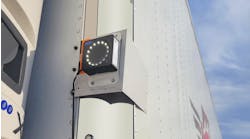With the summer months upon us, many companies find themselves on the precipice of peak customer demand—especially companies that specialize in the last-mile food delivery, critical medicine, and other in-demand refrigerated products. But as business owners and fleet managers start preparing their employees and internal operations to withstand the increased volume of business and deliveries, it’s imperative they do the same with their vehicles.
Some companies across industries are relying on the upcoming peak season to help offset the negative business implications the coronavirus pandemic caused over the last year, but many companies in industries such as foodservice may have seen an uptick in business as a result of the pandemic and increased consumer demand for products that require last-mile delivery. Managers of refrigerated fleets must ensure their vehicles are serviced ahead of peak season, as these vehicles have likely been continuously running since the onset of the pandemic. Proper maintenance can help ensure that no dead battery, shredded tire, or, most importantly, faulty cooling system has the potential to cause any delays that could impact the company’s ability to conduct business.
Last-mile surge
Over the past few years, the number of companies that offer same-day, next-day, and two-day delivery options has significantly increased to meet rising consumer demand; in fact, 41% of consumers have reported they are willing to pay more money for same-day delivery, according to a PWC Global Consumer Insights Pulse Survey. This consumer demand, coupled with businesses’ rising expectations that their suppliers deliver products quickly, has led expedited delivery to become a standard offering across almost all industries.
Competition among businesses to deliver their products as quickly as possible is at an all-time high, which puts an immense strain on logistics and warehouse employees, as well as the long-haul, medium-haul, and last-mile delivery drivers. Since this demand shows no sign of slowing down, many companies have grown their local presence by establishing more warehouses and distribution centers to ensure they are able to quickly fulfill and deliver orders. Added distribution centers create the need for more last-mile delivery drivers, as companies have realized that using more conducive vehicles such as smaller trucks and vans make last-mile deliveries in metropolitan areas much more accessible and time-efficient.
Increasing the number of distribution centers provides companies the chance to expand their business into new markets and achieve both short- and long-term growth, but it also means that their fleets are spread out across more locations. Depending on how far apart these locations are, this creates the potential for some vehicles to be neglected when it comes to maintenance. And since these last-mile delivery vehicles are upfitted with refrigeration systems to keep perishable products safe, it is critical that fleet managers don’t lose track of required vehicle maintenance.
Maintenance evolution
Today, vehicle service intervals are greater and the maintenance they require is less than in years past, but managers should still monitor core items like belts and hoses, brakes, tires, batteries, wiper blades, and—most importantly—the refrigeration systems to maintain proper cargo temperatures, especially in hot regions like the south and southwest. While some companies do this in-house, for businesses located in particularly warm climates, fleet managers should consider taking the extra step of having the vehicle inspected by a professional technician to confirm it is safe and able to get the company through the peak season.
A growing concern is the increasing trend of drivers and operators taking their trucks to quick-stop maintenance shops for basic service. While these facilities are convenient, they aren’t always able to thoroughly inspect and repair brakes, hoses, belts, cables, and other important components, especially the refrigeration systems. It’s important to monitor these parts as a shift in weather can have an impact of varying severity, especially after a particularly cold winter.
A faulty refrigeration system or lack of refrigerant in a hot climate could lead to a significant—in some cases, devastating—loss in product, and in turn, revenue. Therefore, it is especially critical that the vehicle is checked thoroughly by an expert who knows what to look for and address problems accordingly. To take some of the burden off small business owners and fleet managers who are busier than ever, business owners should consider implementing a fleet maintenance program like those offered by The Bancorp, designed to create efficiencies in administrative processes by providing guidance so that servicing and replacing fleets can remain a top priority.
Peak performance
Companies are about to experience an influx in orders as they enter their peak season, and many of their refrigerated vans and trucks will be packed wall-to-wall with perishable product. Regardless of how strategically the vehicle is packed to minimize the amount of time the product is exposed to ambient air, a faulty system, crack in the insulation, or built-up mold can be detrimental to the product, driver’s schedule, and company’s bottom line.
A well-maintained truck also can protect and even enhance the company’s image among both business partners and customers. But every vehicle has a finite lifecycle, and due to the extra cost and lengthy fabrication time to order and upfit a refrigerated vehicle, proper replacement planning is even more important. Cycling vehicles is an effective way to manage repair costs, since replacing vehicles using industry standards can help companies avoid major repairs like transmissions and engine overhauls.
Fleet managers should take steps to make sure the vehicle is being taken care of as it’s used, meaning spills are wiped up quickly, cracks and gaps are addressed when they are noticed, refrigerant levels are always topped off, and systems are checked frequently to confirm they are maintaining a steady temperature.
Another quick and easy way for managers to keep tabs on their vehicles’ refrigeration units is to frequently check the hour meters to track when it’s due for regular maintenance. This can be used as a benchmark and potentially signal if or when it’s time to service the vehicle.
Because of the significant added cost of building a refrigerated and insulated truck or van, smart carriers know that proper maintenance of both the chassis, the insulated cargo area, and the refrigeration system means not only uninterrupted daily service but also extended vehicle life.
Why spring?
Typically, companies with larger fleets that stay on top of their fleet cycling replace vehicles in the fall and spring. But as a result of high demand, production delays caused by the pandemic, and a global computer chip shortage, the current supply of many vehicles is very limited. This means business owners and fleet managers must make plans now to get their new vehicles if they haven’t already; otherwise, they’ll likely need to stick with their current fleet until the 2022 models arrive later in the year.
Using a structured, staggered replacement schedule helps. By staggering their approach, fleet managers can replace their vehicles on a rolling basis, softening the financial impact on the company’s budget and bottom line. It’s extremely rare that a business would replace an entire fleet at once, so most companies already leverage a cyclical, staggered approach. Keep in mind that a good fleet management partner can help plan a proper replacement cycle to keep both vehicle acquisition and maintenance costs at a minimum.
As company vehicles hit the roads this peak season, business owners can be confident they will get the job done safely and effectively by following these maintenance best practices.



